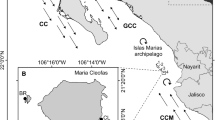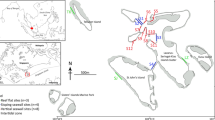Abstract
This study examines the abundances of three morphological categories of juvenile corals (massive, branching and encrusting) on two different types of natural substratum, dead massive and dead branching corals. The overall results show that the morphological characteristics of dead coral substratum have a significant influence on the coral recruitment patterns with respect to the morphology of the recruits: juvenile corals of massive and branching types were more abundant on substrates of corresponding morphology. The results obtained from this study suggest that dead coral might attract coral larvae that are morphologically similar. On the other hand, it may be the result of post-settlement mortality. Whatever the mechanism shaping the patterns is, it seems that the physical morphology of the dead coral substrate has a significant influence on the coral recruit assemblage. Hence, we suggest that substrate morphology can be an important qualitative factor for coral settlement and a possible determinant of community structure.


Similar content being viewed by others
References
Alcala AC (1988) Effects of marine reserves on coral fish abundances and yields of Philippine coral reefs. Ambio 17:194–199
Babcock R (1985) Growth and mortality in juvenile corals (Goniastrea, Platygyra and Acropora): the first year. Proceedings of the 5th international coral reef congress, Tahiti, pp. 355–360
Babcock R, Mundy C (1996) Coral recruitment: consequences of settlement choice for early growth and survivorship in two scleractinians. J Exp Mar Biol Ecol 206:179–201
Baird AH, Babcock RC, Mundy CP (2003) Habitat selection by larvae influences the depth distribution of six common coral species. Mar Ecol Prog Ser 252:289–293
Birkeland C (1997) Life and death of coral reefs. Chapman & Hall, New York
Butman CA (1987) Larval settlement of soft-sediment invertebrates: the spatial scales of pattern explained by active habitat selection and the emerging role of hydrodynamical processes. Oceanogr Mar Biol 25:113–165
Caley MJ, Carr MH, Hixon MA, Hughes TP, Jones GP, Menge BA (1996) Recruitment and the local dynamics of open marine populations. Annu Rev Ecol Syst 27:477–500
Carleton JH, Sammarco PW (1987) Effects of substratum irregularity on success of coral settlement—quantification by comparative geomorphological techniques. Bull Mar Sci 40:85–98
Carlon DB (2002) Production and supply of larvae as determinants of zonation in a brooding tropical coral. J Exp Mar Biol Ecol 268:33–46
Carlon DB, Olson RR (1993) Larval dispersal distance as an explanation for adult spatial pattern in 2 Caribbean reef corals. J Exp Mar Biol Ecol 173:247–263
Chiappone M, Sullivan KM (1996) Distribution, abundance and species composition of juvenile scleractinian corals in the Florida Reef Tract. Bull Mar Sci 58:555–569
Connell JH (1997) Disturbance and recovery of coral assemblages. Coral Reefs 16:S101–S113
Diaz-Pulido G, McCook LJ (2004) Effects of live coral, epilithic algal communities and substrate type on algal recruitment. Coral Reefs (online)
Dunstan PK, Johnson CR (1998) Spatio-temporal variation in coral recruitment at different scales on Heron Reef, southern Great Barrier Reef. Coral Reefs 17:71–81
Edmunds PJ (1991) Extent and effect of black band disease on a Caribbean reef. Coral Reefs 10:161–165
Edmunds PJ (2000a) Patterns in the distribution of juvenile corals and coral reef community structure in St. John, US Virgin Islands. Mar Ecol Prog Ser 202:113–124
Edmunds PJ (2000b) Recruitment of scleractinians onto the skeletons of corals killed by black band disease. Coral Reefs 19:69–74
Edmunds PJ, Bruno JF, Carlon DB (2004) Effects of depth and microhabitat on growth and survivorship of juvenile corals in the Florida Keys. Mar Ecol Prog Ser 278:115–124
English S, Wilkinson CR, Baker V (1997) Survey manual for tropical marine resources. Australian Institute of Marine Science, Townsville, Australia
Gilmour J (1999) Experimental investigation into the effects of suspended sediment on fertilisation, larval survival and settlement in a scleractinian coral. Mar Biol 135:451–462
Glassom D, Zakai D, Chadwick-Furman NE (2004) Coral recruitment: a spatio-temporal analysis along the coastline of Eilat, northern Red Sea. Mar Biol 144:641–651
Harii S, Kayanne H, Takigawa H, Hayashibara T, Yamamoto M (2002) Larval survivorship, competency periods and settlement of two brooding corals, Heliopora coerulea and Pocillopora damicornis. Mar Biol 141:39–46
Harrington L, Fabricius K, De’Ath G, Negri A (2004) Recognition and selection of settlement substrata determine post-settlement survival in corals. Ecology 85:3428–3437
Harriott VJ, Fisk DA (1987) A comparison of settlement plate types for experiments in the recruitment of scleractinian corals. Mar Ecol Prog Ser 37:201–208
Harrison PL, Wallace CC (1990) Reproduction, dispersal and recruitment of Scleractinian corals. In: Dubinsky Z (ed) Ecosystems of the world: coral reefs. Elsevier, Amsterdam
Heyward AJ, Negri AP (1999) Natural inducers for coral larval metamorphosis. Coral Reefs 18:273–279
Hughes TP, Baird AH, Dinsdale EA, Moltschaniwskyj NA, Pratchett MS, Tanner JE, Willis BL (1999) Patterns of recruitment and abundance of corals along the Great Barrier Reef. Nature 397:59–63
Loch K, Loch W, Schuhmacher H, See WR (2002) Coral recruitment and regeneration on a Maldivian reef 21 months after the coral bleaching event of 1998. Mar Ecol 23:219–236
Lugo-Fernandez A, Deslarzes KJP, Price JM, Boland GS, Morin MV (2001) Inferring probable dispersal of Flower Garden Banks coral larvae (Gulf of Mexico) using observed and simulated drifter trajectories. Cont Shelf Res 21:47–67
McGlone MLS, Ranches GD (2003) Water quality assessment of Lingayen Gulf. Philipp Sci 40:41–56
Miller MW, Hay ME (1998) Effects of fish predation and seaweed competition on the survival and growth of corals. Oecologia 113:231–238
Miller MW, Weil E, Szmant AM (2000) Coral recruitment and juvenile mortality as structuring factors for reef benthic communities in Biscayne National Park, USA. Coral Reefs 19:115–123
Morse DE, Hooker N, Morse ANC, Jensen RA (1988) Control of larval metamorphosis and recruitment in sympatric Agariciid corals. J Exp Mar Biol Ecol 116:193–217
Mundy CN (2000) An appraisal of methods used in coral recruitment studies. Coral Reefs 19:124–131
Mundy CN, Babcock RC (1998) Role of light intensity and spectral quality in coral settlement: implications for depth-dependent settlement? J Exp Mar Biol Ecol 223:235–255
Negri AP, Webster NS, Hill RT, Heyward AJ (2001) Metamorphosis of broadcast spawning corals in response to bacteria isolated from crustose algae. Mar Ecol Prog Ser 223:121–131
Nzali LM, Johnstone RW, Mgaya Y (1998) Factors affecting scleractinian coral recruitment on a nearshore reef in Tanzania. Ambio 27:717–722
Obura D, Church J, Daniels C, Kalombo H, Schleyer M, Suleiman M (2004) Status of coral reefs in East Africa 2004: Kenya, Tanzania, Mozambique and South Africa. In: Wilkinson CR (ed) Status of coral reefs of the world: 2004. Australian Institute of Marine Science and Global Coral Reef Monitoring Network, Townsville
Petersen D, Laterveer M, Schuhmacher H (2005) Innovative substrate tiles to spatially control larval settlement in coral culture. Mar Biol 146:937–942
Quinn G, Keough MJ (2002) Experimental design and data analysis for biologists. Cambridge University Press, Cambridge
Raimondi PT, Morse ANC (2000) The consequences of complex larval behavior in a coral. Ecology 81:3193–3211
Reyes MZ, Yap HT (2001) Effect of artificial substratum material and resident adults on coral settlement patterns at Danjugan Island, Philippines. Bull Mar Sci 69:559–566
Richardson LL, Goldberg WM, Kuta KG, Aronson RB, Smith GW, Ritchie KB, Halas JC, Feingold JS, Miller SL (1998) Florida’s mystery coral-killer identified. Nature 392:557–558
Richmond RH (1997) Reproduction and recruitment in corals: critical links in the persistence of reefs. In: Birkeland C (ed) Life and death of coral reefs. Chapman & Hall, New York
Riedmiller S (1998) The Chumbe Island Coral Park Project: management experiences of a private marine conservation project. In: Dight I, Kenchington R, Baldwin J (eds) International tropical marine ecosystems management symposium (ITMEMS), Townsville, Australia, pp. 222–235
Ruiz-Zarate MA, Arias-Gonzalez JE (2004) Spatial study of juvenile corals in the Northern region of the Mesoamerican Barrier Reef System (MBRS). Coral Reefs 23:584–594
Soong K, Chen MH, Chen CL, Dai CF, Fan TY, Li JJ, Fan HM (2003) Spatial and temporal variation of coral recruitment in Taiwan. Coral Reefs 22:224–228
Sprecher SG, Galle S, Reichert H (2003) Substrate specificity and juvenile Faviid predominance of coral colonization at the Maldive Islands following the 1998 bleaching event. Coral Reefs 22:130–132
Terrados J, Duarte CM, Fortes MD, Borum J, Agawin NSR, Bach S, Thampanya U, Kamp-Nielsen L, Kenworthy WJ, Geertz-Hansen O, Vermaat J (1998) Changes in community structure and biomass of seagrass communities along gradients of siltation in SE Asia. Estuar Coast Shelf Sci 46:757–768
Turner SJ (1994) The biology and population outbreaks of the corallivorous gastropod Drupella on Indo-Pacific reefs. Oceanogr Mar Biol 32:461–530
Vermaat JE, Agawin NSR, Duarte CM, Fortes MD, Marba N, Uri JS (1995) Meadow maintenance, growth and productivity of a mixed Philippine seagrass bed. Mar Ecol Prog Ser 124:215–225
Veron JEN (1995) Corals in space and time: the biogeography and evolution of the scleractinia. Cornell University Press, Ithaca
Wilkinson CR (2004) Status of coral reefs of the world: 2004. Australian Institute of Marine Science, Townsville, Australia
Wittenberg M, Hunte W (1992) Effects of eutrophication and sedimentation on juvenile corals. 1. Abundance, mortality and community structure. Mar Biol 112:131–138
Yap HT, Molina RA (2003) Comparison of coral growth and survival under enclosed, semi-natural conditions and in the field. Mar Pollut Bull 46:858–864
Acknowledgments
This project was made possible through financial support by Sida, the Swedish International Development Cooperation Agency. The work of MN is financed by a Sida/SAREC research grant. We would especially like to thank R.M. Dizon, R. Montebon, M. Dimzon, C. Muhando and H. Peeks (CHICOP) for their kind assistance. Thanks are also due to C. Rolff, P. Plantman and M. Löf for assistance with the statistical analysis, and numerous others who provided critical input. The map was provided by ReefBase, and coral reef distribution data by UNEP-WCMC. This is contribution number 352 of the Marine Science Institute, University of the Philippines. All experiments complied with the current laws of the Philippines and Tanzania.
Author information
Authors and Affiliations
Corresponding author
Additional information
Communicated by M. Kühl, Helsingør.
Rights and permissions
About this article
Cite this article
Norström, A.V., Lokrantz, J., Nyström, M. et al. Influence of dead coral substrate morphology on patterns of juvenile coral distribution. Mar Biol 150, 1145–1152 (2007). https://doi.org/10.1007/s00227-006-0458-2
Received:
Accepted:
Published:
Issue Date:
DOI: https://doi.org/10.1007/s00227-006-0458-2




